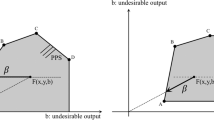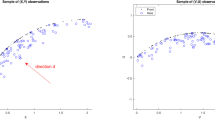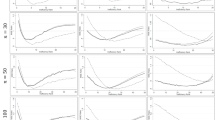Abstract
This paper focuses on solving the problem of technical efficiency estimation for panel data when residuals are right-skewed. Indeed, there is an ambiguity in stochastic frontier analysis when the residuals of the ordinary least squares estimates are right-skewed, which might indicate that either there is no inefficiency, or that the model is misspecified. To overcome and avoid this problem, we propose a panel model in which the inefficiency term has an extended-half-normal distribution. Hence, our work is an extension of existing work for the cross-section case to panel data with time varying inefficiencies. We first propose estimators of the inefficiency under the extended-half-normal distribution assuming independence between the noise and the inefficiency term. A simulation study illustrates the good performance of our procedure. An application to drinking water for forty-two Moroccan municipalities in the period 2017 to 2019 favors our extended model. Results reveal that the performance of this public sector is generally medium and therefore the waste was significant.
Similar content being viewed by others
Availability of Data and Materials
There are two types of data supporting the results of our work. Our simulated data were generated as described in section 3 of this manuscript. As for our real data, we collected them ourselves from Moroccan statistical yearbooks. So, both of them are available, under request, from the corresponding author.
Code Availability
The code is available, under request, from the corresponding author.
References
Aigner, D. J., Lovell, C. A. K., & Schmidt, P. J. (1977). Formulation and estimation of stochastic frontier production function models. Journal of Econometrics, 6, 21–37. https://doi.org/10.1016/0304-4076(77)90052-5
Almanidis, P., Qian, J., & Sickles, R. C. (2014). Stochastic frontier models with bounded inefficiency. In R. C. Sickles & W. C. Horrace (Eds.), Econometric methods and applications (pp. 47–81). Springer Science & Business Media.
Battese, G. E., & Coelli, T. (1988). Prediction of firm-level technical efficiencies with a generalized frontier production function and panel data. Journal of Econometrics, 38, 387–399. https://doi.org/10.1016/0304-4076(88)90053-X
Battese, G. E., & Coelli, T. (1992). Frontier production functions, technical efficiency and panel data: With application to paddy farmers in India. The Journal of Productivity Analysis, 3, 153–169. https://doi.org/10.1007/BF00158774
Coelli, T.J. (1996). A guide to frontier version 4.1: A computer program for stochastic frontier production and cost function estimation. Working paper No. 7/96, Cen- tre for Efficiency and Productivity Analysis (CEPA), University of New England, Australia. Preprint at http://www.uq.edu.au/economics/cepa/frontier.php
Coelli, T.J., & Henningsen, A. (2013). frontier: Stochastic frontier analysis. r package version 1.1. Preprint at http://CRAN.R-Project.org/package=frontier
Daniel, B.C., Hafner, C.M., Manner, H., & Simar, L. (2011). Asymmetries in business cycles and the role of oil production. ISBA discussion paper; 2011/32, p. 23. Preprint at http://hdl.handle.net/2078.1/92536
Debreu, G. (1951). The coefficient of resource utilization. Econometrica, 19, 273–292. https://doi.org/10.2307/1906814
Deprins, D., & Simar, L. (1989). Estimating technical inefficiencies with corrections for environmental conditions with an application to railway companies. Annals of Public and Cooperative Economics, 60, 81–102. https://doi.org/10.1111/j.1467-8292.1989.tb02010.x
El Mehdi, R., & Hafner, C. M. (2014). Local government efficiency: The case of Moroccan municipalities. African Development Review, 26, 88–101. https://doi.org/10.1111/1467-8268.12066
El Mehdi, R., & Hafner, C. M. (2014). Inference in stochastic frontier analysis with dependent error terms. Mathematics and Computers in Simulation (MATCOM), 102, 104–116. https://doi.org/10.1016/j.matcom.2013.09.008
El Mehdi, R., & Hafner, C. M. (2021). Panel stochastic frontier analysis with dependent error terms. International Econometric Review (IER), 13, 24–40. https://doi.org/10.33818/ier.1033722
Farrell, M. J. (1957). The measurement of productive efficiency. Journal of the Royal Statistical Society, 120, 253–290. https://doi.org/10.2307/2343100
Greene, W. H. (1990). A gamma-distributed stochastic frontier model. Journal of Econometrics, 46, 141–163. https://doi.org/10.1016/0304-4076(90)90052-U
Hafner, C. M., Manner, H., & Simar, L. (2018). The “wrong skewness’’ problem in stochastic frontier models: A new approach. Econometric Reviews, 37, 380–400. https://doi.org/10.1080/07474938.2016.1140284
Hajargasht, G. (2015). Stochastic frontiers with a Rayleigh distribution. Journal of Productivity Analysis, 44, 199–208. https://doi.org/10.1007/s11123-014-0417-8
Hollingsworth, B., & Peacock, S. (2008). Efficiency measurement in health and health care (1st ed.). Routledge.
Koopmans, T. C. (1951). An analysis of production as an efficient combination of activities. In T. C. Koopmans (Ed.), Activity analysis of production and allocation (pp. 33–97). Wiley.
Kumbhakar, S. C., & Knox Lovell, C. A. (2000). Stochastic frontier analysis (1st ed.). Cambridge University Press.
Kumbhakar, S.C., Parameter, C.F., Zelenyuk, V. (2018). Stochastic frontier analysis: Foundations and advances. CEPA working paper series, No. WP02/2018, Centre for Efficiency and Productivity Analysis. Preprint at https://ideas.repec.org/p/qld/uqcepa/123.html
Lee, Y. H., & Schmidt, P. (1993). A production frontier model with flexible temporal variation in technical inefficiency. In H. Fried, C. Lovell, & S. Schmidt (Eds.), The measurement of productive efficiency: Techniques and applications (pp. 237–255). Oxford University Press.
Meeusen, W., & Van Den Broeck, J. (1977). Efficiency estimation from Cobb–Douglas production functions with composed error. Econometric Reviews, 18, 435–444. https://doi.org/10.2307/2525757
Migon, H.S., & Medici, E. (2001). A bayesian approach to stochastic production frontier. Technical Report n. 105, DME-IM/UFRJ
Simar, L., & Wilson, P. W. (2010). Inferences from cross-sectional, stochastic frontier models. Econometric Reviews, 29, 62–98. https://doi.org/10.1080/07474930903324523
Stevenson, R. E. (1980). Likelihood functions for generalized stochastic frontier estimation. Journal of Econometrics, 13, 57–66. https://doi.org/10.1016/0304-4076(80)90042-1
Funding
No funding was received for conducting this study.
Author information
Authors and Affiliations
Contributions
The two authors contributed equally to this work.
Corresponding author
Ethics declarations
Conflict of interest
Authors have no Conflict of interest to declare that are relevant to the content of this article.
Ethical Approval
The authors declare that this research doesn’t involve humans and/or animals.
Consent to Participate
Not applicable because no individual consent to participate is necessary for our study.
Consent for Publication
Not applicable because no individual consent to participate is necessary for our study.
Additional information
Publisher's Note
Springer Nature remains neutral with regard to jurisdictional claims in published maps and institutional affiliations.
Appendices
Appendix 1: Proof of Theorem 1: Error Term Density When the Inefficiency Component is an Extended-Half-Normal
Proof
Knowing that the inefficiency term \(u_{i}\) is an extended-half-normal, that \(0<u_i<B\) and \(\epsilon _{it} = v_{it}- \eta \left( t\right) u_i\) and given that \(f_{\epsilon ,u}\) is the \(\left( \epsilon _i, u_i\right) \) joint density, \(f_1\) is the \(v_{it}\) density function and \(f_{\gamma }^-\) is the \(u_i\) density function, we have
\(\square \)
Appendix 2: Proof of Theorem 2: Technical Efficiency When the Inefficiency Component is an Extended-Half-Normal
Proof
If we denote \(f_2\) the density of \((u_i\mid \epsilon _i )\), we have
\(\square \)
Rights and permissions
Springer Nature or its licensor (e.g. a society or other partner) holds exclusive rights to this article under a publishing agreement with the author(s) or other rightsholder(s); author self-archiving of the accepted manuscript version of this article is solely governed by the terms of such publishing agreement and applicable law.
About this article
Cite this article
El Mehdi, R., Hafner, C.M. Panel Stochastic Frontier Analysis with Positive Skewness. Comput Econ (2024). https://doi.org/10.1007/s10614-024-10646-w
Accepted:
Published:
DOI: https://doi.org/10.1007/s10614-024-10646-w




